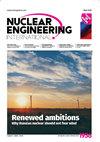Application of the WCOBRA/TRAC Best Estimate Methodology to the AP600 Large-Break LOCA Analysis
IF 0.6
4区 工程技术
Q4 Engineering
引用次数: 0
Abstract
The AP600 is a simplified advanced pressurized water reactor (PWR) design incorporating passive safety systems that perform the same function as the active emergency core cooling systems (ECCSs) on the current reactors. In order to verify the effectiveness of the AP600 design features for mitigation of a postulated large-break loss-of-coolant accident (LOCA), the recently USNRC-approved best-estimate LOCA methodology (BELOCA) was applied to perform the AP600 standard safety analysis report large-break LOCA analysis. The applicability of the WCOBRA/TRAC code to model the AP600 unique features was validated against CCTF and UFTE downcomer injection tests, the blowdown and reflood cooling heat transfer uncertainties were re-assessed for the AP600 large-break LOCA conditions, and a conservative minimum film boiling temperature was applied as a bounded parameter for blowdown cooling. The BELOCA methodology was simplified to quantify the code uncertainties due to local and global models as well as the statistical approximation methods, with the other uncertainties being bounded by limiting assumptions on the initial and boundary conditions. The final 95 percentile peak cladding temperature (PCT95%) was 1186 K, which meets the 10CFR50.46 criteria with a considerable margin. It is therefore concluded that the AP600 design is effective in mitigation of a postulated large-break LOCA.WCOBRA/TRAC最佳估计方法在AP600大断裂LOCA分析中的应用
AP600是一种简化的先进压水堆(PWR)设计,采用被动安全系统,其功能与目前反应堆上的主动应急堆芯冷却系统(eccs)相同。为了验证AP600设计特征在缓解假定的大断裂冷却剂损失事故(LOCA)方面的有效性,最近usnrc批准的最佳估计LOCA方法(BELOCA)被应用于AP600标准安全分析报告的大断裂LOCA分析。通过CCTF和UFTE降水管注入试验验证了WCOBRA/TRAC代码对AP600独特特性建模的适用性,重新评估了AP600大间隙LOCA条件下的放空和回流冷却传热不确定性,并采用保守的最小膜沸腾温度作为放空冷却的有界参数。简化了BELOCA方法,以量化由于局部和全局模型以及统计近似方法引起的代码不确定性,其他不确定性由初始条件和边界条件的限制性假设限制。最终95百分位峰值熔覆温度(PCT95%)为1186 K,满足10CFR50.46标准。因此得出结论,AP600设计在缓解假定的大断裂LOCA方面是有效的。
本文章由计算机程序翻译,如有差异,请以英文原文为准。
求助全文
约1分钟内获得全文
求助全文
来源期刊

Nuclear Engineering International
工程技术-核科学技术
自引率
0.00%
发文量
0
审稿时长
6-12 weeks
期刊介绍:
Information not localized
 求助内容:
求助内容: 应助结果提醒方式:
应助结果提醒方式:


